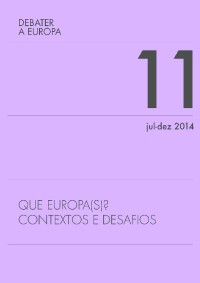Please use this identifier to cite or link to this item:
https://hdl.handle.net/10316.2/33989| DC Field | Value | Language |
|---|---|---|
| dc.contributor.author | Cunha, Alice | - |
| dc.date.accessioned | 2014-10-13T14:47:01Z | |
| dc.date.accessioned | 2020-09-24T01:06:06Z | - |
| dc.date.available | 2014-10-13T14:47:01Z | |
| dc.date.available | 2020-09-24T01:06:06Z | - |
| dc.date.issued | 2014 | - |
| dc.identifier.issn | 1647-6336 | - |
| dc.identifier.uri | https://hdl.handle.net/10316.2/33989 | - |
| dc.description.abstract | Nos anos 90, a questão do alargamento, primeiro dos países nórdicos e depois dos de leste, dominou a agenda da União Europeia (UE). Enquanto ainda se negociava a adesão da Áustria, Finlândia e Suécia, que iriam aderir a 1 de Janeiro de 1995, tornavase evidente que os países da Europa Central e de Leste, finda a Guerra Fria e capacitados para desenvolver a sua própria política externa, também pretendiam candidatar-se à adesão. Mas já anteriormente se haviam concretizado três rondas de alargamento (em 1973, 1981 e 1986) e, no futuro, se realizariam outras três (em 2004, 2007 e 2013). Assunto negligenciado no âmbito da teoria da integração regional e europeia até ao próprio alargamento a leste, a política do alargamento tem sido uma constante na agenda da UE e é mesmo considerada como “a mais bem sucedida política externa” da mesma. Este artigo pretende assim analisar a génese, a natureza e os traços evolutivos da política do alargamento da UE, socorrendo-se das características (semelhantes e/ou distintas) das diferentes rondas de alargamento. | por |
| dc.description.abstract | In the 1990 s, enlargement, first regarding the EFTA countries and then the Eastern European countries, dominated the European Union s (EU) agenda. While Austria, Finland and Sweden accession negotiations were still taking place, it became clear that, after the end of the Cold War and empowered to develop their own foreign policy, Central and Eastern European countries would also apply for membership. In the past, there had already occurred three enlargement rounds (in 1973, 1981 and 1986) and in the future three others (in 2004, 2007 and 2013). Neglected subject in the regional and European integration theory until the Eastern enlargement itself, the enlargement policy has always been on the EU s agenda and is even considered as “the most successful foreign policy” of the EU. This article will assess the origin, nature and evolution of the EU s enlargement policy, by comparing the similar or distinguish features of several enlargement rounds. | eng |
| dc.language.iso | por | - |
| dc.publisher | Centro de Informação Europe Direct de Aveiro | - |
| dc.publisher | Centro de Estudos Interdisciplinares do Século XX | - |
| dc.subject | Enlargement policy | eng |
| dc.subject | European Union | eng |
| dc.subject | Política do alargamento | por |
| dc.subject | União Europeia | por |
| dc.title | A política do alargamento da União Europeia: génese, natureza e evolução | por |
| dc.type | article | - |
| uc.publication.collection | Debater a Europa n.º 11 | - |
| uc.publication.firstPage | 349 | - |
| uc.publication.issue | 11 | - |
| uc.publication.lastPage | 371 | - |
| uc.publication.location | Aveiro | - |
| uc.publication.journalTitle | Debater a Europa | - |
| dc.identifier.doi | 10.14195/1647-6336_11_18 | - |
| uc.publication.section | Parte V: Europa política, regional e económica | - |
| uc.publication.orderno | 20 | - |
| uc.publication.area | Ciências Sociais | - |
| uc.publication.manifest | https://dl.uc.pt/json/iiif/10316.2/33989/238401/manifest?manifest=/json/iiif/10316.2/33989/238401/manifest | - |
| uc.publication.thumbnail | https://dl.uc.pt/retrieve/11596025 | - |
| item.grantfulltext | open | - |
| item.fulltext | With Fulltext | - |
| Appears in Collections: | Debater A Europa | |
Files in This Item:
| File | Description | Size | Format | |
|---|---|---|---|---|
| debateraeuropa11_artigo19.pdf | 369.01 kB | Adobe PDF |  |
Items in DSpace are protected by copyright, with all rights reserved, unless otherwise indicated.
